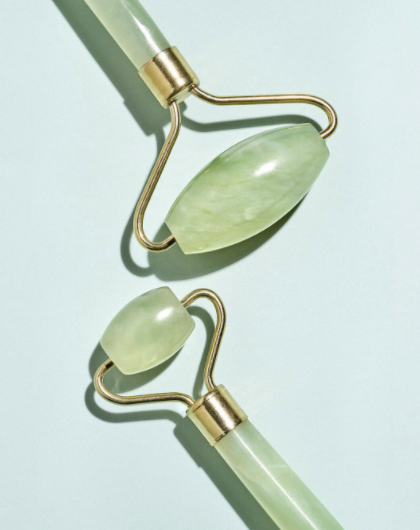Counterintuitive Skincare Trends

Jade rollers have become the new aesthetic addition to vanities across the globe, but dermatologists have contested the results they claim to produce.
January 26, 2021
Let’s face it: Since our days have become full of Zoom meetings in which we stare at our faces in the little boxes on the screen for hours on end, skincare has come to the forefront of our attention. Every single real or imaginary flaw is on display for the world to see, and thus, skincare products have become trendy once more. Some products are true to their claims, but many of them, unfortunately, fall flat. These are just a few of the latter group that we’d recommend taking a closer look at before buying.
Jade Rollers
Gorgeous pale colors, chic marble patterns and descriptors like “amethyst” and “quartz” have all contributed to jade rollers becoming a staple tool in many beauty routines. They claim to reduce swelling, shape your face and have all the benefits of a facial massage.
If it sounds too good to be true, that’s probably because it is. There is not sufficient science-based evidence that proves their claims to reduce puffiness and that actually makes sense when you really think about it. That type of light physical pressure cannot actually reshape your face, and while it can be soothing, it’s not as effective as an actual massage. That’s not to say that they can’t be useful; If you’ve incorporated serums into your routine, jade rollers can help them penetrate deeper into the skin, past the epidermis (the upper layer of your skin). They’re also just really pretty, and for $10-$20, some have argued that it’s not a bad investment.
Charcoal Masks
Charcoal has been used for centuries for many reasons, including topical applications for treating wounds and water purification. Recently, it has become even more popular in the beauty industry, with charcoal masks being popular for their perceived ability to detoxify the skin by sticking to and drawing out impurities.
Again, though, there isn’t much concrete evidence to back up these claims. While charcoal doesn’t harm skin and has some exfoliating and cleansing properties, in mask-form, the actual content of activated charcoal isn’t sufficient enough to truly detoxify your skin.
Pore Strips
This next product has been around for awhile, and has been featured by characters in various coming-of-age movies, so it’s not surprising that a lot of us have grown up seeing and using them. They’re satisfying in a gross kind of way, and that’s probably why people love using them—they’re meant to take all the gunk out of your pores, and you can actually see it once you pull them off.
However, they only remove the surface layer of oil, sebum and dirt that’s lying on your skin, which all eventually come back anyways. Before they do, however, your pores are left exposed to the elements and can end up more irritated than before. So, yes, you can use them, but just know that the benefits are superficial and you have to be careful when doing so to avoid making your skin even worse.
Facial Scrubs
Charcoal masks and pore strips both aim to, in broad terms, exfoliate the skin. Another common method of doing this, albeit more directly, is through facial scrubs. These aren’t inherently bad for your skin, but it depends on the ingredients. An infamous example of this is St. Ive’s Apricot Scrub, which uses ground apricot pits that can cause microtears in the skin. That’s the biggest problem with physical exfoliant scrubs; they’re too harsh and abrasive.
A more suitable alternative for many is chemical exfoliants. It can be a little scary to use chemicals on your skin, especially when that word is often associated with cleaning objects and not the skin you put so much effort into taking care of, but the chemical exfoliants meant for skin are much gentler. The more common ones contain alpha-hydroxy acids (AHAs) or beta-hydroxy acids (BHAs), or both. These can actually penetrate your pores and can even loosen bonds that hold skin cells together, effectively cleaning up the top layer of your skin without causing microtears. Still, it’s good to remember that they are acids and as such can be harsh, so just like with any product, spot test first!
Eye creams
Finally, we have eye creams. These are meant to reduce the appearance of various occurrences, including swelling and dark circles near the eyes.
Specific ingredients can target treatment to achieve desired results. However, it’s important to note that not all eye creams are equal and will help with the promised results. An ingredient like caffeine might not make a big difference in improving dark circles, but can help puffiness because it works as a vasoconstrictor. Eye creams are overrated if marketed as cure-alls, which is why many people consider them to be useless in favor of the products they use all over their face.
In general, for any skincare product: check all the ingredients and make sure they are what you’re looking for, and check credible reviews to see how they’ve affected others. While it’s easy to be charmed by an aesthetic dropper with “brightens, cleanses and clears skin” written in typewriter font, it’s the ingredients in them that really tell you what that product will and won’t work for you.



![AAAAAND ANOTHER THING: [CENSORED] [REDACTED] [BABY SCREAMING] [SIRENS] [SILENCE].](https://thehowleronline.org/wp-content/uploads/2025/06/lucy-1200x800.jpg)
















































![AAAAAND ANOTHER THING: [CENSORED] [REDACTED] [BABY SCREAMING] [SIRENS] [SILENCE].](https://thehowleronline.org/wp-content/uploads/2025/06/lucy-300x200.jpg)



